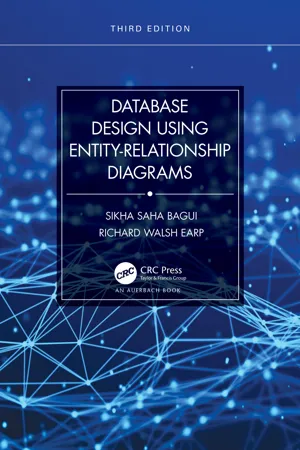
- 358 pages
- English
- ePUB (mobile friendly)
- Available on iOS & Android
Database Design Using Entity-Relationship Diagrams
About this book
Essential to database design, entity-relationship (ER) diagrams are known for their usefulness in data modeling and mapping out clear database designs. They are also well-known for being difficult to master. With Database Design Using Entity-Relationship Diagrams, Third Edition, database designers, developers, and students preparing to enter the field can quickly learn the ins and outs of data modeling through ER diagramming.
Building on the success of the bestselling first and second editions, this accessible text includes a new chapter on the relational model and functional dependencies. It also includes expanded chapters on Enhanced Entity-Relationship (EER) diagrams and reverse mapping. It uses cutting-edge case studies and examples to help readers master database development basics and defines ER and EER diagramming in terms of requirements (end user requests) and specifications (designer feedback to those requests), facilitating agile database development. This book
- Describes a step-by-step approach for producing an ER diagram and developing a relational database from it
-
- Contains exercises, examples, case studies, bibliographies, and summaries in each chapter
-
- Details the rules for mapping ER diagrams to relational databases
-
- Explains how to reverse engineer a relational database back to an entity-relationship model
-
- Includes grammar for the ER diagrams that can be presented back to the user, facilitating agile database development
-
The updated exercises and chapter summaries provide the real-world understanding needed to develop ER and EER diagrams, map them to relational databases, and test the resulting relational database. Complete with a wealth of additional exercises and examples throughout, this edition should be a basic component of any database course. Its comprehensive nature and easy-to-navigate structure make it a resource that students and professionals will turn to throughout their careers.
Frequently asked questions
- Essential is ideal for learners and professionals who enjoy exploring a wide range of subjects. Access the Essential Library with 800,000+ trusted titles and best-sellers across business, personal growth, and the humanities. Includes unlimited reading time and Standard Read Aloud voice.
- Complete: Perfect for advanced learners and researchers needing full, unrestricted access. Unlock 1.4M+ books across hundreds of subjects, including academic and specialized titles. The Complete Plan also includes advanced features like Premium Read Aloud and Research Assistant.
Please note we cannot support devices running on iOS 13 and Android 7 or earlier. Learn more about using the app.
Information
Table of contents
- Cover
- Half Title
- Title
- Copyright
- Dedication
- Contents
- Preface
- Acknowledgments
- Authors
- Introduction
- Chapter 1 Data, Databases, and the Software Engineering Process
- Chapter 2 Data and Data Models
- Chapter 3 The Relational Model and Functional Dependencies
- Chapter 4 The Basic ER Diagram: A Data Modeling Schema
- Chapter 5 Beyond the First Entity Diagram
- Chapter 6 Extending Relationships/Structural Constraints
- Chapter 7 The Weak Entity
- Chapter 8 Further Extensions for ER Diagrams with Binary Relationships
- Chapter 9 Ternary and Higher-Order ER Diagrams
- Chapter 10 The Enhanced Entity-Relationship (EER) Model
- Chapter 11 Relational Mapping and Reverse Engineering ER/EER Diagrams
- Chapter 12 A Brief Overview of the Barker/Oracle-Like Model
- Glossary
- Index